Related Research Articles

A carpet is a textile floor covering typically consisting of an upper layer of pile attached to a backing. The pile was traditionally made from wool, but since the 20th century, synthetic fibers such as polypropylene, nylon or polyester are often used, as these fibers are less expensive than wool. The pile usually consists of twisted tufts that are typically heat-treated to maintain their structure. The term carpet is often used in a similar context to the term rug, but rugs are typically considered to be smaller than a room and not attached to the floor.

A Persian carpet or Persian rug, also known as Iranian carpet, is a heavy textile made for a wide variety of utilitarian and symbolic purposes and produced in Iran, for home use, local sale, and export. Carpet weaving is an essential part of Persian culture and Iranian art. Within the group of Oriental rugs produced by the countries of the "rug belt", the Persian carpet stands out by the variety and elaborateness of its manifold designs.

A kilim is a flat tapestry-woven carpet or rug traditionally produced in countries of the former Persian Empire, including Iran, the Balkans and the Turkic countries. Kilims can be purely decorative or can function as prayer rugs. Modern kilims are popular floor coverings in Western households.
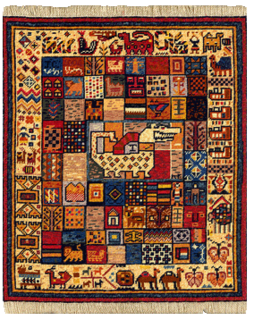
Gabbeh or gabba carpets are a traditional variety of Persian carpet. Gabbeh is known as gava in Kurdish and Luri and is also called khersak (خرسک) in Bakhtiari, literally meaning a "bear's cub". Traditionally a sleeping rug, a gabbeh is a hand-woven pile rug of coarse quality and medium size characterized by an abstract design that relies upon open fields of color and a playfulness with geometry. This type of rug is popular among the populations of the Zagros Mountains of Iran, including Kurdish, Luri and Qashqai people. The gabbeh is usually crafted by women.
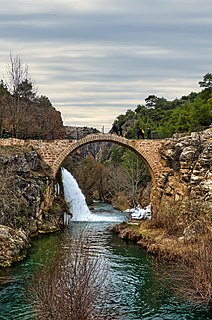
Uşak is a city in the interior part of the Aegean Region of Turkey. The city has a population of 500,000 and is the capital of Uşak Province.
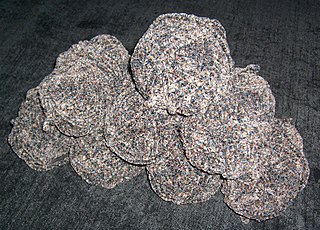
Chenille is a type of yarn, or fabric made from it. Chenille is the French word for caterpillar whose fur the yarn is supposed to resemble.

Uşak carpets, Ushak carpets or Oushak Carpets are Turkish carpets that use a particular family of designs, called by convention after the city of Uşak, Turkey – one of the larger towns in Western Anatolia, which was a major center of rug production from the early days of the Ottoman Empire, into the early 20th century.
An oriental rug is a heavy textile made for a wide variety of utilitarian and symbolic purposes and produced in "Oriental countries" for home use, local sale, and export.

Bergama Carpet refers to handwoven Turkish carpets, made in the Bergama district in the Izmir Province of northwest Turkey. As a market place for the surrounding villages, the name of Bergama is used as a trade name to define the provenience.

Anatolian rug is a term of convenience, commonly used today to denote rugs and carpets woven in Anatolia and its adjacent regions. Geographically, its area of production can be compared to the territories which were historically dominated by the Ottoman Empire. It denotes a knotted, pile-woven floor or wall covering which is produced for home use, local sale, and export. Together with the flat-woven kilim, Anatolian rugs represent an essential part of the regional culture, which is officially understood as the Culture of Turkey today, and derives from the ethnic, religious and cultural pluralism of one of the most ancient centres of human civilisation.
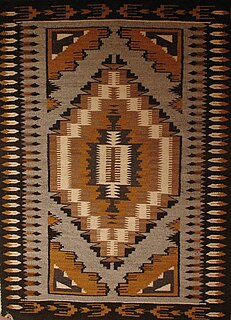
Navajo rugs and blankets are textiles produced by Navajo people of the Four Corners area of the United States. Navajo textiles are highly regarded and have been sought after as trade items for over 150 years. Commercial production of handwoven blankets and rugs has been an important element of the Navajo economy. As one expert expresses it, "Classic Navajo serapes at their finest equal the delicacy and sophistication of any pre-mechanical loom-woven textile in the world."

Hereke carpets are Turkish handmade carpets produced and sold in Hereke, a coastal town in Turkey. For a long time, they used to be produced only in Hereke, 60 km from Istanbul. The materials used are silk, a combination of wool and cotton, and sometimes gold or silver threads.

A knotted-pile carpet is a carpet containing raised surfaces, or piles, from the cut off ends of knots woven between the warp and weft. The Ghiordes/Turkish knot and the Senneh/Persian knot, typical of Anatolian carpets and Persian carpets, are the two primary knots. A flat or tapestry woven carpet, without pile, is a kilim. A pile carpet is influenced by width and number of warp and weft, pile height, knots used, and knot density.

Azerbaijani rugs are traditional rugs made in Azerbaijan. The Azerbaijani rug is a handmade textile of various sizes, with a dense texture and a pile or pile-less surface, whose patterns are characteristic of Azerbaijan's many carpet-making regions. Traditionally, the carpets were used in Azerbaijan to cover floors, decorate interior walls, sofas, chairs, beds and tables.

The term Armenian carpet designates, but is not limited to, tufted rugs or knotted carpets woven in Armenia or by Armenians from pre-Christian times to the present. It also includes a number of flat woven textiles. The term covers a large variety of types and sub-varieties. Due to their intrinsic fragility, almost nothing survives—neither carpets nor fragments—from antiquity until the late medieval period.
Kapotex Industries is a manufacturer of woolen & other blends of carpet yarns used in the production of machine-made, hand-made rugs & broadloom wall-to-wall carpets. Headquartered in Mumbai, Maharashtra, it specializes in manufacturing yarns for Axminster Weaving, Face-to-Face Weaving, Wilton Jacquard Weaving, and Tufting Broadloom Carpets & Rugs including mechanized hand tufted & pass tufted carpets and rugs.
DOBAG is the Turkish acronym for "Doğal Boya Araştırma ve Geliştirme Projesi". The project aims at reviving the traditional Turkish art and craft of carpet weaving. It provides inhabitants of a rural village in Anatolia – mostly female – with a regular source of income. The DOBAG initiative marks the return of the traditional rug production by using hand-spun wool dyed with natural colours, which was subsequently adopted in other rug-producing countries.
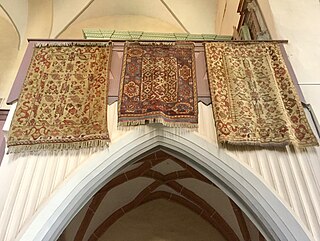
The name Transylvanian rug is used as a term of convenience to denote a cultural heritage of 15th–17th century Islamic rugs, mainly of Ottoman origin, which have been preserved in Transylvanian Protestant churches. The corpus of Transylvanian rugs constitutes one of the largest collections of Ottoman Anatolian rugs outside the Islamic world.

Uzbek carpet is one of the best-known handmade carpets produced by Uzbeks. Carpet weaving, being one of the types of Uzbek arts and crafts, is inextricably linked with other kinds of Uzbek arts and crafts, continuing the tradition of other types of national fine art. Originally carpet in Uzbekistan is flourishing in such villages as Kamashi, Hadzhaki and Jeynov in Kashkadarya region.

The Oriental Carpet Manufacturers (OCM) was a London-based company involved in the production of, and trade with, Oriental carpets. Established in 1907/8 in Istanbul, the company set up and controlled their own carpet manufactures in the central Anatolian region around the town of Konya, and from 1911 onwards, in the Hamadan Province in northwestern Iran. In 1968 it was sold, and merged with one of its former affiliates, the Eastern Kayyam Company. From 1924 until 1948, OCM was led by Arthur Cecil Edwards, who, after retiring, wrote a text book on Persian Carpets, which is still in print today.
References
- ↑ Βογιατζόγλου, Ο.,Μικρά Ασία, Η Άγνωστη Πισιδία, Η Καθημερίνη Επτά Ημέρες [Voyatzoglou, Ο., Asia Minor: The Unknown Pisidia, Kathimerini newspaper Seven Days] 16,3,1997
- ↑ Ιστικοπούλου, Λ., Η ελληνική ταπητουργία και η ταπητουργός στη Μικρά Ασία (1860-1922), Αθήνα: Εστία, 2000 [Istikopoulou, L., Greek carpet making and carpet making in Asia Minor (1860-1922), Athens, Hestia Publications, 2000].
- ↑ Wynn, A., Three Camels to Smyrna, Hali Publications 2008
- ↑ Quataert, D., “Carpet making”, in Quataert, D., Ottoman Manufacturing in the Age of the Industrial Revolution, Cambridge: Cambridge University Press, 1993, 134-160.
- ↑ Τρακάκης, Γ., Η βιομηχανία εν Σμύρνη και εν τη ελληνική Μικρασία, επιμ. Χρ. Σολδάτος, Αθήνα: Τροχαλία, 1994.
- ↑ Quataert, D., "Ottoman manufacturing in the 19th century", in Quataert, D.,Manufacturing in the Ottoman Empire and Turkey, 1500-1950, σελ. 109. Quataert believes that in the beginning of the 20th century Smyrna had 800 looms
- ↑ Stone, P., Oriental Rugs: An Illustrated Lexicon of Motifs, Materials, and Origins
- ↑ Stone, P., Oriental Rugs: An Illustrated Lexicon of Motifs, Materials, and Origins
- ↑ Encyclopédie méthodique, ou, par ordre de matières, vol.2, Paris 1892
- ↑ Gregoriann, A.T., Oriental rugs and the stories they tell, Sribner 1977
- ↑ Goswami, K.K.(ed.), Advances in Carpet Manufacture, 2017
- ↑ Παπαδάκη, Ι.-Α., «Ο σπαρταλής Ιορδάνης Στύλογλου (1875-1948). Συμβολή στην ανάπτυξη της ταπητουργίας στην Σπάρτη της Μικράς Ασίας»,Δελτίο της Εταιρείας Μελέτης τηςΚαθ’ ημάς Ανατολής 2 (2006), 161-175.
- ↑ Mardin, S., Religion and Social Change in Modern Turkey: The Case of Bediuzzaman Said Nursi, State University of New York 1199
- ↑ Όλγα Βογιατζόγλου, «Η βιομηχανική εγκατάσταση στη Νέα Ιωνία - Παράμετρος εγκατάστασης», στο συλλογικό τόμο Ο ξεριζωμός και η άλλη πατρίδα, ό.π., σσ. 150-156
- ↑ Bureau of Foreign and Domestic Commerce, World Trade in Commodities, United States 1949, vol. 7, parts 9-24.